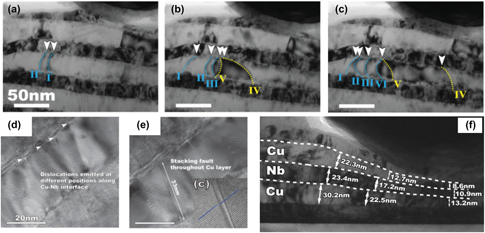Crossref Citations
This article has been cited by the following publications. This list is generated based on data provided by
Crossref.
Dewapriya, M.A.N.
and
Miller, R.E.
2020.
Molecular dynamics study of the mechanical behaviour of ultrathin polymer–metal multilayers under extreme dynamic conditions.
Computational Materials Science,
Vol. 184,
Issue. ,
p.
109951.
Sáenz-Trevizo, A
and
Hodge, A M
2020.
Nanomaterials by design: a review of nanoscale metallic multilayers.
Nanotechnology,
Vol. 31,
Issue. 29,
p.
292002.
Dewapriya, M. A. N.
and
Miller, R. E.
2020.
Superior Dynamic Penetration Resistance of Nanoscale Multilayer Polymer/Metal Films.
Journal of Applied Mechanics,
Vol. 87,
Issue. 12,
Powers, Max
Derby, Benjamin
Shaw, Alex
Raeker, Evan
and
Misra, Amit
2020.
Microstructural characterization of phase-separated co-deposited Cu–Ta immiscible alloy thin films.
Journal of Materials Research,
Vol. 35,
Issue. 12,
p.
1531.
Derby, Benjamin K.
Chatterjee, Arya
and
Misra, Amit
2020.
Metal-ion-controlled growth and nanoindentation response of 3D, bicontinuous Cu–Fe thin films.
Journal of Applied Physics,
Vol. 128,
Issue. 3,
Jiang, Li
Powers, Max
Cui, Yuchi
Derby, Benjamin K.
and
Misra, Amit
2021.
Microstructure and mechanical properties of nanoscale Cu/(Ta50Nb25Mo25) multilayers.
Materials Science and Engineering: A,
Vol. 799,
Issue. ,
p.
140200.
Dewapriya, M.A.N.
and
Miller, R.E.
2021.
Energy absorption mechanisms of nanoscopic multilayer structures under ballistic impact loading.
Computational Materials Science,
Vol. 195,
Issue. ,
p.
110504.
Dewapriya, M.A.N.
and
Miller, R.E.
2021.
Molecular dynamics study of the penetration resistance of multilayer polymer/ceramic nanocomposites under supersonic projectile impacts.
Extreme Mechanics Letters,
Vol. 44,
Issue. ,
p.
101238.
Song, Jian
Wang, Jian
and
Liu, Yue
2021.
Characterization of the terrace-defect interfaces using in situ straining techniques.
Journal of Materials Research,
Vol. 36,
Issue. 13,
p.
2674.
Jian, Wu-Rong
Su, Yanqing
Xu, Shuozhi
Ji, Weisen
and
Beyerlein, Irene J.
2021.
Effect of interface structure on dislocation glide behavior in nanolaminates.
Journal of Materials Research,
Vol. 36,
Issue. 13,
p.
2802.
Chen, Xiang
2021.
Effect of phase interface atomic coherency on dynamics of dislocations.
Journal of Materials Research,
Vol. 36,
Issue. 13,
p.
2792.
Jian, Wu-Rong
Xu, Shuozhi
Su, Yanqing
and
Beyerlein, Irene J.
2022.
Role of layer thickness and dislocation distribution in confined layer slip in nanolaminated Nb.
International Journal of Plasticity,
Vol. 152,
Issue. ,
p.
103239.
Dewapriya, M.A.N.
and
Miller, R.E.
2023.
Polyurea.
p.
273.
Li, Jia
Mahdavi, Behnam
Baghayeri, Mehdi
Rivandi, Behnaz
Lotfi, Maryam
Mahdi Zangeneh, Mohammad
Zangeneh, Akram
and
Tayebee, Reza
2023.
A new formulation of Ni/Zn bi-metallic nanocomposite and evaluation of its applications for pollution removal, photocatalytic, electrochemical sensing, and anti-breast cancer.
Environmental Research,
Vol. 233,
Issue. ,
p.
116462.
Zhang, Jie
Chen, Ru
Chen, Shuainan
Yu, Die
Elkamchouchi, Dalia H.
Alqahtani, Mohammed S.
Assilzadeh, Hamid
Huang, Zhongguan
and
Huang, Yideng
2023.
Application of lipid and polymeric-based nanoparticles for treatment of inner ear infections via XGBoost.
Environmental Research,
Vol. 239,
Issue. ,
p.
117115.
Xie, Hongtao
Zhou, Haofei
Chew, Huck Beng
and
Li, Ruizhi
2024.
Atomistic investigation of interface-dominated deformation mechanisms in nanolayered Cu–Ag eutectic alloy.
Journal of Materials Science,
Vol. 59,
Issue. 32,
p.
15382.
Wang, Liqiang
Wang, Heyi
Zhou, Xin
Fu, Huangliu
Surjadi, James Utama
Qu, Shuo
Song, Xu
Fan, Rong
and
Lu, Yang
2024.
Hierarchical crystalline–amorphous nanocomposites with high strength and large deformability enabled by elemental diffusion.
Journal of Materials Science & Technology,
Vol. 171,
Issue. ,
p.
150.
Yang, Sheng-Nan
Xie, Hui
Guan, Huai
and
Jin, Hai-Jun
2024.
Recoverable tuning of lattice mismatch and strength in ultrastable-nanostructured Cu/Ag spinodoid alloys.
Acta Materialia,
Vol. 269,
Issue. ,
p.
119827.
Goswami, R.
Pande, C.S.
Moser, A.
and
Wollmershauser, J.A.
2025.
Behavior of Al-Al2O3 metal/ceramic multilayers under indentation and shock loadings.
Materialia,
Vol. 40,
Issue. ,
p.
102394.



